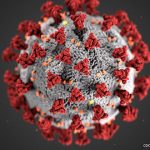Antibody Response in COVID-19
Much remains to be learned about the antibodies that appear in response to SARS-CoV-2. Most commonly, antibodies appear in serum one to three weeks after symptoms start. However, somewhat atypically for viruses, at least in some people IgM antibodies are delayed. Several publications have shown that IgG appears before IgM in COVID-19, and IgG is found at much higher concentrations compared to IgM.
Antibody development in SARS-CoV-2 seems to correspond to a decreased viral load in the respiratory tract.3 However, Kamran Kadkhoda, PhD, D(ABMM), D(ABMLI), medical director of the immunopathology laboratory at the Cleveland Clinic, points out that individuals with critical illness from COVID-19 have higher than average antibody levels. Thus, it is unclear exactly what role the antibodies are playing in recovery. He notes that up to a third of patients either don’t mount a neutralizing antibody response at all or do so only at very low levels.
It is not known how long IgM and IgG antibodies remain detectable following infection, but they may be present when an individual is still shedding viral particles and so still able to infect others.3 Dr. Kadkhoda adds, “I’ve heard anecdotally from some colleagues that individuals lose their titers, the antibody levels, almost five to six weeks after they are positive for the virus by [polymerase chain reaction testing].”
Cassandra Calabrese, DO, trained as a rheumatologist and infectious disease specialist and is associate staff at the Cleveland Clinic. She underscores a key open question surrounding these antibodies, asking, “Is IgG reliable for telling if you are immune to COVID-19? The short answer is no. We are hoping that infection will generate protective and long-lasting IgG antibodies, but now we just don’t know.”
Some other common coronaviruses possibly provide immunity for at least a limited time. Early primate studies show that rhesus macaques develop neutralizing antibodies that seem to prevent reinfection.4 However, Dr. Kadkhoda points out these animals have only been followed for weeks, not for months or years. “There is a possibility that the immunity, if there is such a thing as immunity at all, is short lived.”
Antibody Serological Testing in SARS-CoV-2
For identifying active SARS-CoV-2 infection, researchers use tests based on polymerase chain reaction (PCR) to identify the viral genetic material present in throat or nasal swabs. Such molecular, nucleic acid-based tests are intended to recognize active SARS-CoV-2 infection but will not identify previously infected individuals who have already cleared the virus.
In contrast, serologic antibody tests are designed to reveal the presence of IgG and IgM. In the early days of an infection, these antibodies are not present at detectable levels. Thus, such tests should never be used as the sole means to diagnose active infection, though they might theoretically help identify previously infected individuals.5
Many such tests have been rapidly developed over the last several months, differing somewhat in basic design and other characteristics. Some assess IgG only; others provide information on both IgG and IgM; some provide “total antibody” readings. Some require a blood draw, and others are designed to be performed with only a pinprick sample. While some can be performed only in labs capable of high complexity testing, others can be done in laboratories with more basic resources.6
These serological antibody tests are typically designed using recombinant (noninfectious) antigen based on the SARS-CoV-2 spike protein or nucleocapsid phosphoprotein (the two most common antibody targets). This allows such testing to be performed in a wide variety of labs, in contrast to studies performed with live virus, which must be performed in highly specialized labs meeting requisite biosafety standards.3
Many are enzyme-linked immunosorbent assays (ELISAs), a common laboratory platform that can be used to assess antibody concentration. The test utilizes a plate coated with a recombinant viral protein. Patient samples are incubated with the protein, and any antibodies to the virus will bind. These antibodies can then be detected by another (anti-human) binding antibody that produces a visible fluorescent or luminescent readout. Similarly, chemiluminescence immunoassays generate light signals proportional to SARS-CoV-2 antibodies. Both tests may be able to provide quantitative or semi-quantitative information about antibody concentration, although currently available commercial tests do not supply information about antibody titers.5
In contrast, lateral flow immunoassays provide positive or negative results without any quantitative information. Antibodies from the serum sample bind to recombinant viral antigens in the test strip and are wicked laterally by capillary action along its length. In the indicator region, these are bound by anti-human antibodies, which are immobilized and held in the indicator region, where they accumulate with some sort of colorant that can be assessed by a reader.1
Such kits are cheap and easy to use, and they can be used as point-of-care assays. However, they are not amenable to mass automation and large-scale testing in the same way that ELISA or chemiluminescence type tests are.1
Critically, these antibody tests are not designed to specifically measure neutralizing antibodies. Assessment of neutralizing antibodies requires much more sophisticated testing such as plaque reduction neutralization tests (PRNT). Such tests assess the effects of the antibodies on the active live virus via cell culture, but few test developers have the capability to perform such tests because of biosafety requirements.
Most of the SARS-CoV-2 antibody tests have not been validated via PRNT.7 However, some have claimed to find a correlation between titers from ELISA and titers assessed through neutralization tests.8



